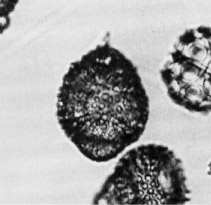 Lithopera
(Lithopera) renzae Sanfilippo and Riedel
Lithopera
(Lithopera) renzae Sanfilippo and Riedel Lithopera
(Lithopera) renzae Sanfilippo and Riedel
Lithopera
(Lithopera) renzae Sanfilippo and RiedelLithopera (Lithopera) renzae Sanfilippo and Riedel, 1970, p.454, pl.1, figs.21-23, 27
Subellipsoidal shell, of which the thorax forms the major part. Cephalis spherical, usually with small circular pores, half or more of it enclosed in the thoracic wall, with a small apical horn. Collar stricture not usually pronounced externally. From the base of the cephalis, primary lateral and dorsal spines extend in the thoracic wall or within the thoracic cavity to join the inner surface of the upper wall. Remainder of shell subellipsoidal, with pores very irregular in size and arrangement, tending to form a spongy meshwork especially in the upper part of the thorax. In some specimens the thoracic wall is not actually spongy, but the pores are divided by secondary bars. Inverted-hemispherical or inverted-conical abdomen usually separated from the larger thorax by a distinct stricture and change in contour (Sanfilippo and Riedel, 1970).
Based on 30 specimens. Total length (excluding horn) 100-165 µm. Maximum breadth 80-110 µm. Ratio of length of abdomen to length of thorax (measured from base of cephalis) (0.01-1.3):1, usually (0.3-0.7):1 (Sanfilippo and Riedel, 1970).
Total length 100-180 µm; maximum breadth 80-120 µm (Sanfilippo et al., 1985).
Closed subellipsoidal shell, of which the thorax forms the major part. Pores irregular, tending to be spongy (especially proximally). Lumbar stricture distinct (Riedel and Sanfilippo, 1978a).
L. renzae is distinguished from the other members of its genus by having a third segment delineated by a lumbar stricture usually accompanied by a change in contour. Co-occurring Cyrtocapsella japonica (Nakaseko, 1963, p.143, text-figs.20-21, pl.4, figs.1-3) is three-segmented and similar in shape, but its pores are more regularly arranged, never spongy, and its abdomen is usually larger than the thorax (Sanfilippo et al., 1985).
The thorax forms the major part of the three-segmented ellipsoidal shell. In some specimens the cephalis may be free, but more often it is half or more enclosed in the thoracic wall. The shell wall varies from irregularly spaced pores to subdivided pores to a spongy meshwork. The abdomen is inverted-conical or inverted hemispherical and as little as 0.01, to as much as 1.5 times the length of the thorax (Sanfilippo et al., 1985).
This species is found in most middle Miocene assemblages from latitudes lower than 40°. Its morphotypic first appearance and its evolutionary transition to Lithopera neotera both lie within the Dorcadospyris alata Zone.
Lithopera renzae may be a descendant of the four-segmented Stichocorys diploconus Haeckel (1887, p.1513, pl.78, fig.6), and gives rise to Lithopera neotera by loss of the lumbar stricture.
Additional illustrations can be found in Riedel and Sanfilippo, 1971, pl.2E, figs.17-18, pl.7, fig.14; 1978a, pl.6, fig.11.